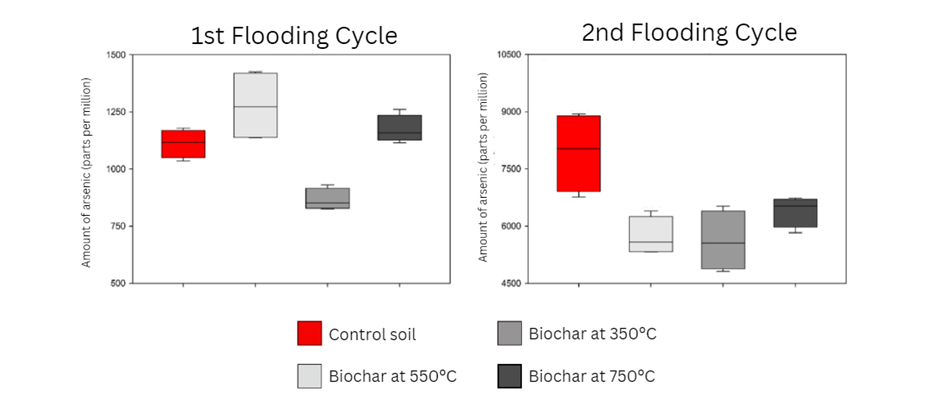Superfund Research Program
High-Temperature Biochar for Arsenic Remediation
Release Date: 11/01/2023
![]() subscribe/listen via iTunes, download(5.8MB), Transcript(89KB)
subscribe/listen via iTunes, download(5.8MB), Transcript(89KB)
Adding biochar produced at a high temperature may be an effective way to immobilize arsenic in sediment, according to researchers partially funded by the NIEHS Superfund Research Program (SRP). The study, led by Owen Duckworth, Ph.D., of the University of North Carolina at Chapel Hill SRP Center, in partnership with researchers from the Luiz de Queiroz College of Agriculture, University of São Paulo, Brazil, also provided further insight into the conditions that influenced the effectiveness of biochar for soil remediation.
Biochar is a substance formed by heating organic matter, such as plant material, at high temperatures in the partial or total absence of oxygen. The material can be mixed into soil to adsorb and bind to certain contaminants like arsenic — a naturally occurring element linked to a variety of health issues, including cancer, cardiovascular disease, and respiratory problems.
However, biochar can degrade over time, releasing organic carbon, which can convert arsenic into a water-soluble, more easily dispersed form. Although biochar is often used to remediate arsenic-contaminated soil, not much is known about how to improve its efficacy.
Testing the Biochar Mixtures
The researchers hypothesized that heating the biochar to different temperatures would affect the chemical composition of the material. According to the team, changing the composition of biochar may affect how much organic carbon is released and impact the biochar’s ability to remediate arsenic.
To test their hypothesis, the team produced biochar by heating sugarcane straw at three temperatures: 350 °C, 550 °C, and 750 °C.
The biochars were mixed with soil contaminated with arsenic and allowed to age for 30 days. Each biochar and soil mixture, along with a control of only soil, went through two cycles of flooding with water for 30 days before draining for 10 days. Finally, the researchers collected water and soil samples after each flooding cycle to analyze for arsenic and organic carbon content.
Results showed that heating biochar to higher temperatures made the material less likely to release organic carbon. The lack of organic carbon means less arsenic will be converted into its mobile form, the authors explained. Higher temperatures also created more pores in the biochar particles, increasing the surface area available to adsorb arsenic.

Biochar Affects Redox Fluctuations
The research team also found that biochar significantly decreased the amount of dissolved arsenic in water compared to the soil without biochar after the second flooding cycle, but not the first cycle. They hypothesized that biochar may help regulate reduction and oxidation potential in soil, which can affect if arsenic remains dissolved in water or precipitates out. Reduction and oxidation (redox) potential measures the ability of a chemical species to gain or lose — reduce or oxidize, respectively — an electron under certain conditions.
To test this, they used probes in soil and water to measure the redox state for each mixture and found that soils amended with high temperature biochar became less reduced during the second flooding cycles. The redox state may change the physical and chemical properties of the biochar, causing it to immobilize arsenic more efficiently, the scientists explained.

According to the authors, this study demonstrates that biochar, particularly biochar formed at higher temperatures, is an effective soil additive for arsenic remediation. They recommend that more studies be carried out to examine how the movement of electrons affects biochar efficacy and the environmental conditions necessary for electron movement, such as the presence of water or pH of the soil.
For More Information Contact:
Owen Duckworth
North Carolina State University
Department of Crop & Soil Sciences
Williams Hall 3208, Box 7620-7619
Raleigh, North Carolina 27695
Phone: 919-513-1577
Email: owen_duckworth@ncsu.edu
To learn more about this research, please refer to the following sources:
- Soares MB, Duckworth O, Styblo M, Cable PH, Alleoni LR. 2023. Pyrolysis temperature and biochar redox activity on arsenic availability and speciation in a sediment. J Hazard Mater 460:132308. doi:10.1016/j.jhazmat.2023.132308 PMID:37639794
To receive monthly mailings of the Research Briefs, send your email address to srpinfo@niehs.nih.gov.


